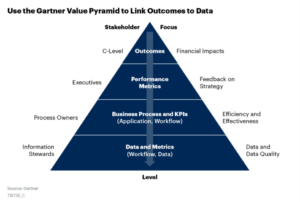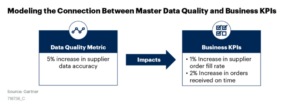How to Measure and Communicate the Business Value of Master Data Management (MDM)


In 18 March 2025
Master Data Management (MDM) is essential for organizations aiming to maintain a single, reliable view of critical data entities such as customers, suppliers, and products. However, despite its importance, many data and analytics leaders struggle to quantify and communicate the business value of MDM effectively. As a result, MDM initiatives often fail to secure long-term funding and executive buy-in. Instead of getting caught up in technical metrics, it’s important to focus on how MDM contributes to real business success. So, how do you prove its value?
The Challenge: Connecting MDM to Business Value
One of the most common misconceptions among data leaders is that the impact of MDM on business outcomes is either unmeasurable or unnecessary to measure. Instead, organizations often focus on low-level operational metrics such as data quality or standardization, which do not directly convey MDM’s contribution to overall business success.
Without a clear link between MDM improvements and tangible business results, MDM programs risk being deprioritized, leading to poor stakeholder engagement and insufficient investment.
Establishing a Structured Approach to Measurement
To overcome this challenge, data leaders should adopt a structured framework to quantify the business value of MDM. This involves:
1. Aligning MDM Strategy with Business Goals
MDM should support an organization’s overarching data and analytics strategy, ensuring it aligns with corporate objectives.
MDM is a foundational component of all digitalization and transformation programs and enables four different types of business goals.
- The first goal is to better “run the business” by optimizing current performance and operations and reducing the regulatory compliance risks (Data Protection, SOX).
- The second goal is to “grow the business” by improving performance and expanding capabilities (new markets, new products, increased satisfaction).
- The third goal is to “transform the business” by driving innovation and bringing agility (for rapidly changing and evolving business contexts).
- The fourth goal is to “reduce technical debt” by removing the disparate business languages used across organizations’ departments and adhering to a common language and master data.
Identifying relevant business stakeholders and their goals is critical to ensuring that MDM efforts contribute meaningfully to the organization’s success.
2. Using a Value-Based Metrics Framework
Business outcomes should be mapped hierarchically to master data elements and performance metrics. The Gartner Business Value Pyramid provides a structured way to link high-level business objectives to data-driven metrics.
MDM value must be communicated in a language everyone understands. Senior executives focus on strategic goals while operational managers track tactical performance indicators.

3. Quantifying Business Impact
Business outcomes typically fall into four categories: risk reduction, revenue growth, cost savings, and corporate governance.
MDM enables any data domain 360° view. For instance, a single view of the customer and product domains improves the ability to understand your customers better, leading to better opportunities for upselling, cross-selling, better customer satisfaction, and customer retention. New products and services can be brought to market much faster and ahead of the competition. For example, MDM programs should use business modeling techniques to estimate how data quality improvements impact key performance indicators (KPIs).

Other examples of measurable business outcomes include increased customer satisfaction, revenue growth from cross-selling opportunities, and cost reductions through supply chain optimization.
4. Aggregating and Communicating Business Value
The final step involves aggregating the measured impacts and linking them to financial results. Collaboration with finance and business units is necessary to create credible impact models. Stakeholders should be provided with clear, quantifiable evidence of how MDM contributes to strategic goals. Continuous monitoring and iteration ensure that MDM’s business value remains visible and well-documented. By following these steps, organizations can build a strong case for MDM investment and demonstrate its ongoing value to the business.
For MDM programs to succeed, data and analytics leaders must shift from purely technical metrics to a structured approach demonstrating clear business benefits. By aligning MDM with corporate goals, applying a value-based framework, and quantifying business impact, organizations can effectively communicate MDM’s value to stakeholders, securing long-term commitment and investment.
At APGAR, we support businesses in tackling these challenges by offering expert guidance, customized methodologies, and proven frameworks to drive a smooth and value-focused data transformation.
Gartner, Market Guide for Software Asset Management Tools, Sally Parker, Andrew White , 19 July 2023
Gartner does not endorse any vendor, product or service depicted in its research publications, and does not advise technology users to select only those vendors with the highest ratings or other designation. Gartner research publications consist of the opinions of Gartner’s research organization and should not be construed as statements of fact. Gartner disclaims all warranties, expressed or implied, with respect to this research, including any warranties of merchantability or fitness for a particular purpose.
GARTNER is a registered trademark and service mark of Gartner, Inc. and/or its affiliates in the U.S. and internationally and is used herein with permission. All rights reserved.
This graphic was published by Gartner, Inc. as part of a larger research document and should be evaluated in the context of the entire document. The Gartner document is available upon request from APGAR.
Would you like to get in touch with our experts?
If you agree, disagree or have something to add to these views on corporate strategy, please contact us.